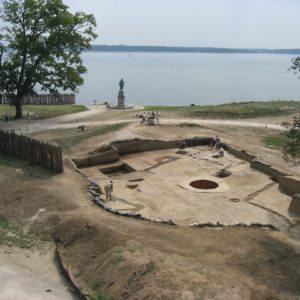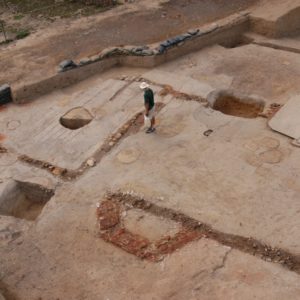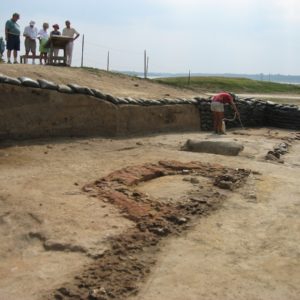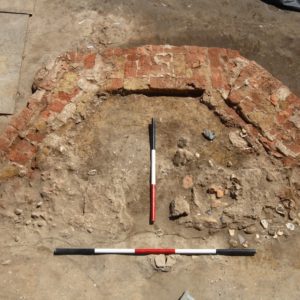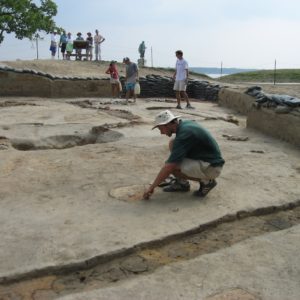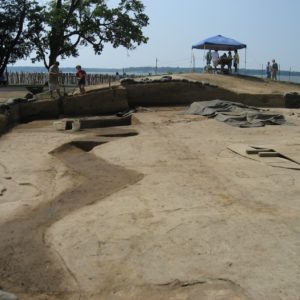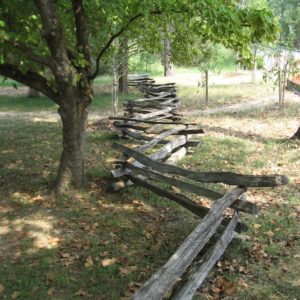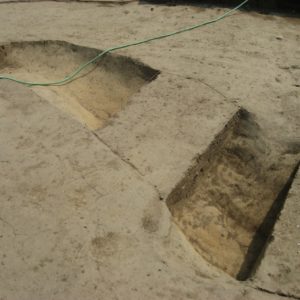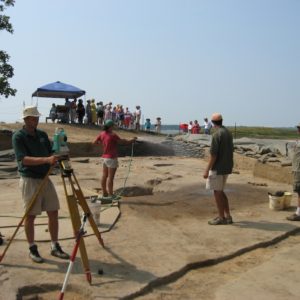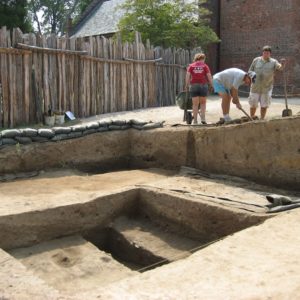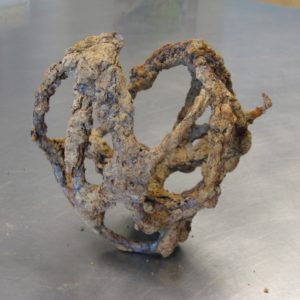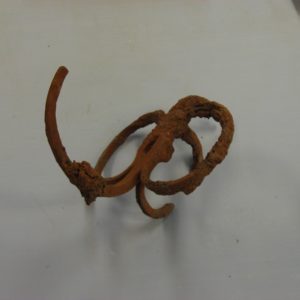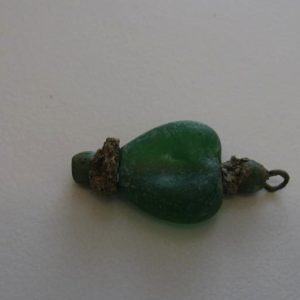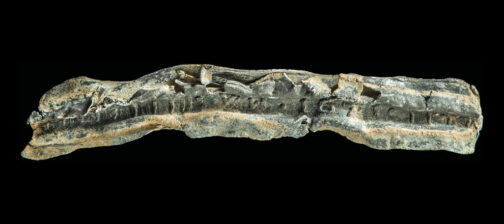Another interesting underground feature has been discovered by the archaeologists at Historic Jamestowne. Although it is far too early to tell definitively what it is, probing of the feature has revealed that it is several feet deep. This would suggest that it could be a cellar or even another well. Significant artifacts have been excavated from the top layers of the feature, including two sword hilts and a Border ware vessel. Nearby, archaeologists have uncovered several other significant features, all contained within the bounds of the original three-sided fort.
A large and very early underground feature has been discovered close to the northern bulwark of James Fort. Located just inside the eastern palisade wall and not far from an early well that was excavated over the past several months, only the top layers of the feature have been excavated yet it is already yielding several impressive artifacts. At this point, the feature could turn out to be one of a number of things, but preliminary probing has revealed that it is at least six feet deep.
The archaeologists speculate that it might be some sort of underground storage structure such as a cellar, or it could even be another well. The feature is several feet long on each side and it was constructed very early in the history of James Fort. Archaeologists have drawn the conclusion that it dates to the period in which James Fort was still standing because several other features cut through it that also stood during the fort period. Because the feature is transected by several features but it transects none, it is the oldest of the features in the area. Newer features built over older ones will naturally transect them. To see a visual explanation of this, click on the diagram below.
Two sword hilts, one from a rapier and one from a sword with a wider blade, were found in the underground feature. The rapier hilt is of a swept style and is similar to several other rapier hilts that have been found elsewhere in the fort area. It dates to the early 17th century. This one is very well preserved and is largely devoid of large rust encrustations. The other sword hilt, a basket hilt most likely of Scottish origin, has a significant amount of rust encasing its intricate design and will require several hours of conservation to restore a semblance of its original appearance. Other basket hilts have also been found at James Fort. A piece of Border ware pottery was excavated from the feature, nearly intact except for its missing handle. Though its purpose is not 100% certain, the piece was likely part of a larger assembly used to warm liquids. It would have fit on top of a fuming pot for this purpose. Further excavations in the coming months will undoubtedly produce more artifacts and give us a clearer picture of the exact nature of the underground feature where these artifacts were found.
Excavations just to the southwest of the early well have uncovered a pit with a posthole inside it. This is the fifth in a series of pits which have been found just inside the western palisade wall. These pits are thought to be an example of the earliest form of shelter for the colonists, as the historical record indicates that they did indeed sleep in shallow holes in the earliest days of James Fort. The posthole may be evidence of a wooden support for a lean-to-type roof. Part of the cobblestone foundation for a 1611 building cuts through the pit, indicating it was dug before that year. An artifact that may be part of a rosary or an earring was discovered in the pit. It consists of a copper wire threaded through beads made from bone, lead or pewter spacers, and a large, heart-shaped glass bead. The copper wire has tarnished the bone beads over time so that they are now green like the wire itself.
A ditch with an interesting zig-zag shape was found running through the northern part of the James Fort area. The ditch dates to the second half of the 17th-century, long after the fort itself had disappeared. The purpose of the ditch was probably to keep livestock separated from another part of the town. A fence would have been built on one side of the ditch to help keep the animals out. The reason for the unusual zig-zag shape becomes evident when viewing a recreation of a split-rail fence, a style of fence that was popular at the time. By its nature, a split-rail fence has a zig-zag shape and the ditch echoed its path. An Elizabethan silver three pence minted between 1561 and 1582 was found when excavating a section of the trench.
related images
- Aerial view of the James Fort dig, August 28 2006
- Aerial view of the dig site
- Bay window foundation which was part of the 1617-1618 extension to the governor’s house
- Bay window foundation
- View of the recreated western palisade wall, crosses mark discovered colonist graves
- Western palisade wall in foreground with individual postholes clearly visible
- View of the zig-zag ditch, sprayed with water to make the feature more visible
- Recreation of a split-rail fence
- The zig-zag ditch showing test excavations
- Elizabethan silver three pence found in the zig-zag ditch excavation
- Jamestown Rediscovery archaeologists at the dig site
- Underground feature
- Basket hilt
- Swept rapier hilt
- Pit with posthole visible near the top left of the pit floor
- This bead found in the pit with a posthole may be part of a rosary or an earring
- Diagram showing an older archaeological feature being transected by two newer features



